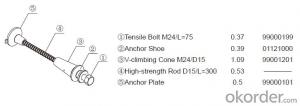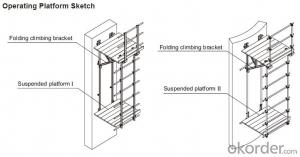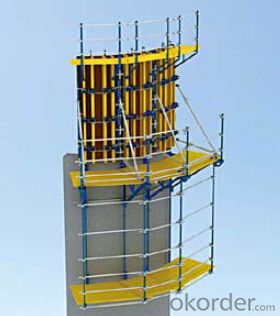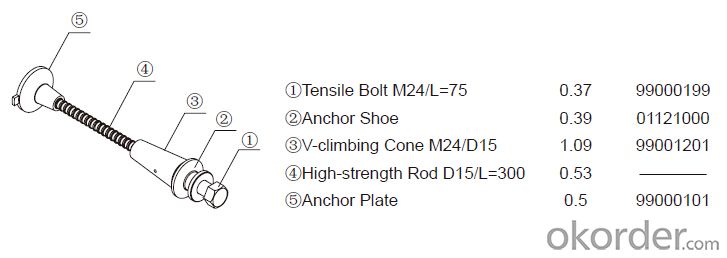Climbing Platform CP-190 for formwork and scaffolding system
- Loading Port:
- Tianjin
- Payment Terms:
- TT OR LC
- Min Order Qty:
- 50 m²
- Supply Capability:
- 1000 m²/month
OKorder Service Pledge
OKorder Financial Service
You Might Also Like
Climbing Platform CP190
Climbing bracket CP190 is mainly used as operating platform during construction. It can be used
on the vertical wall and arced wall. The bracket hang on the anchor system and all the load are
supported by anchor system. It’s convenient to assemble and dismantle, the construction is easy,
rapid and safe.
Anchor System:
Anchor system is the most important supporting part. The system is made of five parts shown
below. There into, tensile bolt, anchor shoe and V-climbing cone can be taken out for reusing.
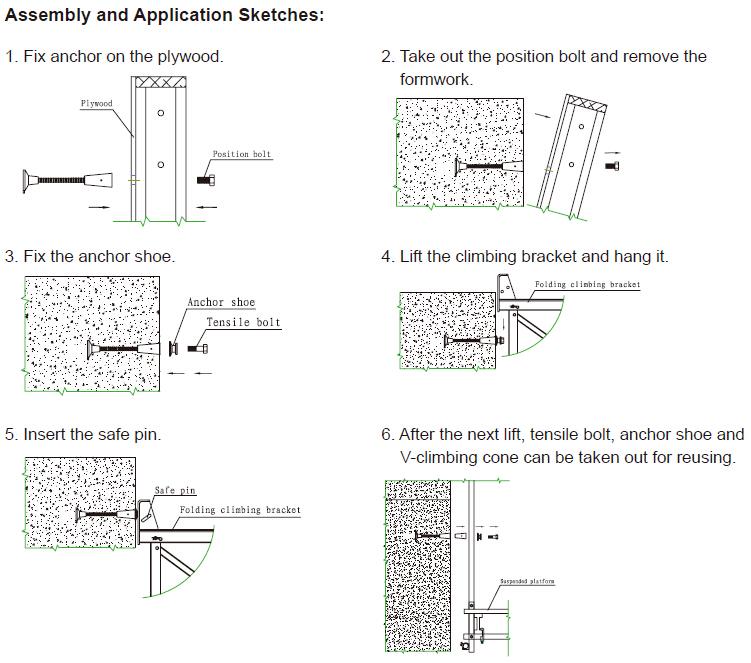
- Q: Can steel formwork be used in areas with limited access or space constraints?
- Indeed, the use of steel formwork is viable in areas with limited access or space constraints. Renowned for its versatility and adaptability, steel formwork proves itself suitable for a wide range of construction projects, even those with restricted access or limited space. The malleability of steel formwork facilitates its easy customization and fabrication to meet the specific dimensions and shapes required for each unique project. This flexibility empowers construction teams to work efficiently in areas with restricted access or space constraints, such as narrow alleys, confined construction sites, or towering buildings. Furthermore, steel formwork boasts high strength and durability, which are imperative when operating in demanding environments. It effectively withstands heavy loads, furnishing stability to the concrete structure and ensuring both safety and structural integrity. Additionally, steel formwork can be promptly assembled and disassembled, allowing for effortless transportation and installation in areas with restricted access. Its lightweight nature facilitates convenient handling and maneuverability, diminishing the need for cumbersome machinery or equipment. In conclusion, the adaptability, strength, durability, and ease of assembly exhibited by steel formwork render it an ideal choice for areas with limited access or space constraints. By utilizing this construction technique, construction teams can efficiently operate in challenging environments, guaranteeing the successful completion of their projects.
- Q: Can steel formwork be used for both straight and sloping structures?
- Yes, steel formwork can be used for both straight and sloping structures. Steel formwork is highly versatile and can be easily adjusted to accommodate various angles and curves, making it suitable for constructing both straight and sloping structures efficiently and effectively.
- Q: What are the different material handling requirements for steel formwork?
- Steel formwork offers numerous advantages in construction projects, such as its durability, reusability, and ability to withstand high pressure and loads. However, it is important to consider specific material handling requirements associated with steel formwork. Firstly, when handling and transporting steel formwork panels, it is crucial to use suitable lifting equipment like cranes or forklifts. This ensures that the load is evenly distributed and reduces the risk of dropping or damaging the panels during transportation. Secondly, proper storage is essential to prevent rust and corrosion. The panels should be stored in a dry and well-ventilated area. Additionally, they should be stacked evenly to avoid deformation. It is important to stack them in a way that allows easy access to individual panels without causing damage to others. Regular cleaning and maintenance are necessary to ensure the longevity and reusability of steel formwork. After each use, the formwork should be cleaned to remove any concrete residue, dirt, or debris. Additionally, it is important to inspect the formwork for any signs of damage, such as cracks or bends, and repair or replace them as needed. Skilled workers are required for the proper assembly and disassembly of steel formwork. The panels need to be accurately aligned and securely connected to form a watertight structure. During disassembly, care should be taken to avoid damaging the panels, ensuring they can be reused in the future. To enhance the durability and lifespan of steel formwork, surface protection measures should be taken. This includes applying anti-corrosion coatings or paint to prevent rust and corrosion. Regular inspections should be conducted to identify any signs of damage or deterioration on the surface, and necessary actions should be taken to maintain the integrity of the formwork. In conclusion, adhering to the material handling requirements for steel formwork, such as proper handling and transportation methods, appropriate storage and stacking, regular cleaning and maintenance, skilled assembly and disassembly, and surface protection measures, is essential for optimal performance and longevity in construction projects.
- Q: Can steel formwork be used for bridge piers?
- Yes, steel formwork can be used for bridge piers. It offers high strength, durability, and flexibility, making it suitable for constructing bridge piers that require a sturdy and reliable structure. Additionally, steel formwork allows for easy customization and reusability, making it a cost-effective and efficient choice for bridge pier construction.
- Q: Can steel formwork be used for both residential and industrial construction projects?
- Steel formwork is suitable for both residential and industrial construction projects. It is a versatile and durable solution that can withstand the demands of various construction projects. It offers a high level of strength and stability, making it suitable for small-scale residential projects as well as large-scale industrial projects. Furthermore, steel formwork has the added benefit of being reusable, which can help save costs and reduce waste in construction projects. It is also easy to assemble and disassemble, making it a practical choice for different types of projects. In conclusion, steel formwork is a reliable and efficient option for both residential and industrial construction projects.
- Q: What are the different types of bracing used with steel formwork?
- There are several types of bracing commonly used with steel formwork, including diagonal bracing, horizontal bracing, and vertical bracing. Diagonal bracing is used to provide stability and resistance against lateral forces, while horizontal bracing helps to control deflection and ensure the formwork remains in place. Vertical bracing is used to support the formwork system vertically and prevent any potential collapse. These different types of bracing work together to ensure the safety and stability of the steel formwork during construction.
- Q: How does steel formwork handle different concrete curing time requirements?
- Steel formwork proves to be a versatile and durable choice for construction projects, including those involving concrete structures. In terms of managing diverse concrete curing time needs, steel formwork presents numerous advantages. To begin with, steel formwork establishes a sturdy and secure framework for pouring concrete. This guarantees that the concrete remains in place and retains its desired shape throughout the curing process. Irrespective of the required curing time, steel formwork effectively withstands the weight and pressure exerted by the concrete, preventing any distortion or collapse. Furthermore, steel formwork boasts high adjustability and customizability. It can be easily modified to accommodate varying curing time requirements. For instance, if a specific section of concrete necessitates a lengthier curing time, supplementary support can be added to the steel formwork, providing extra strength and stability. Conversely, if a section requires a shorter curing time, the steel formwork can be adjusted accordingly to expedite the curing process. In addition, steel formwork possesses excellent heat conductivity properties. This facilitates efficient dissipation of heat during concrete curing. Different concrete mixes may generate heat at varying rates during hydration, and steel formwork assists in maintaining consistent curing temperatures. This proves particularly advantageous when dealing with concrete structures that demand specific curing temperatures. Moreover, steel formwork is reusable and capable of enduring multiple casting cycles. Consequently, it can be utilized for diverse projects with varying concrete curing time requirements, making it a cost-effective option. The durability and strength of steel formwork ensure its longevity, enabling contractors to adapt to different curing time needs without the need for constant replacement. In conclusion, steel formwork proves to be highly suitable for managing different concrete curing time requirements. Its stability, adjustability, heat conductivity, and reusability render it an ideal selection for construction projects of varying scales and complexities. Whether the concrete necessitates a longer or shorter curing time, steel formwork provides the essential support and flexibility to ensure successful curing and the creation of robust and enduring concrete structures.
- Q: What type of finishes can be achieved with steel formwork?
- Steel formwork offers a variety of finishes for concrete structures, making it a versatile option. Smooth finishes can be achieved using steel formwork, giving the concrete a seamless and uniform appearance. This finish is ideal for architectural purposes or when a clean and modern look is desired. Textured finishes are also possible with steel formwork. Different textures, such as wood grain or brick patterns, can be incorporated onto the surface of the formwork, transferring them onto the concrete during casting. This creates an aesthetically pleasing finish that adds depth and interest to the structure. Furthermore, steel formwork allows for patterned surfaces to be created. Intricate designs or motifs can be incorporated onto the formwork panels, resulting in unique and decorative finishes on the concrete surface. This type of finish is often used in architectural applications that require specific designs or branding elements. In conclusion, steel formwork provides the flexibility and precision needed to achieve a wide range of finishes for concrete structures. Whether it's a smooth, textured, or patterned finish, steel formwork enables the desired aesthetic outcome to be realized.
- Q: How does steel formwork affect the overall acoustic properties of the structure?
- Steel formwork does not have a significant impact on the overall acoustic properties of a structure. However, it may slightly reduce sound transmission due to its dense and rigid nature compared to other formwork materials such as wood or plastic.
- Q: How does steel formwork handle different concrete testing procedures?
- Steel formwork is highly versatile and can easily handle different concrete testing procedures. Its sturdy and strong structure ensures that it can withstand the pressure and weight of the concrete during testing. Additionally, steel formwork provides a smooth and even surface, which is crucial for accurate testing results. It can also be easily dismantled and reassembled, making it convenient for various testing procedures. Overall, steel formwork is well-suited to handle different concrete testing procedures due to its durability, stability, and adaptability.
Send your message to us
Climbing Platform CP-190 for formwork and scaffolding system
- Loading Port:
- Tianjin
- Payment Terms:
- TT OR LC
- Min Order Qty:
- 50 m²
- Supply Capability:
- 1000 m²/month
OKorder Service Pledge
OKorder Financial Service
Similar products
Hot products
Hot Searches
Related keywords

